Breastfeeding Twin Babies

When I first thought about breastfeeding, I was excited for how intimate and snugly the experience would be. I imagined quietly nursing my baby while rocking in a glider, a soothing yet empowering Sarah McLaughlin song playing in the background.
And then I found out I was having twins…
Breastfeeding twins?! Goodbye soothing music, and hello (oh-so-annoying) whir of the pump! How was I ever going to juggle two on the boob at once? Seriously, if singleton moms report feeling like a dairy cow, imagine nursing a litter (a small litter, but a litter nonetheless).
But let me set the record straight: breastfeeding twins is possible. To be honest, I’m not sure anyone—no matter how many babies they have—enjoys that “soothing scene” I mentioned in the beginning (not even newbie singleton moms). But with a little prep work and practice, it’s doable and totally worthwhile.
How to Prepare
If these babies are your first (and second), I recommend a breastfeeding class at your hospital – bonus points if it’s specifically geared towards multiples; the cost can be covered with your FSA (Flexible Spending Account). Even if you’ve already done this before with a singleton, I would check it out because feeding (especially simultaneously) two is different.
In fact, there were some veteran moms and dads in our class and they all learned some important twin-specific tips. We even got to practice “tandem-feeding” dolls, an awkward but useful exercise.
Gear
True, cave women didn’t have all kinds of fancy gear and did just fine, but, a bit of well-placed gear will help you stay comfortable while nursing, and comfort is the name of the game.
Nursing Pillow
First, please get a twin nursing pillow; our favorite is the Twin Z Nursing pillow, but read up on all the twin nursing pillows.
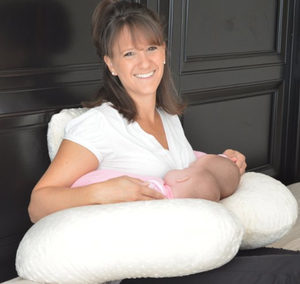
Breast Pumps
Many a multiple mama is an exclusive pumper (in lingo: EP’er). Even if you plan on exclusively feeding from the breast, I am here to tell you that you’ll still need a good pump (and you can get one for free) to help establish your supply and stock up on your liquid gold. You have the option of a hospital pump, a personal pump, or a combo of both.
By the way, a great time to pump is in the morning when your milk supply is at its max.
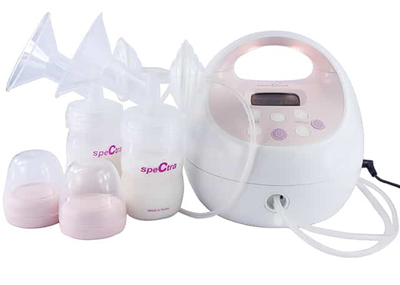
Now that you have all the equipment, let’s talk lactation consultants….
Lactation Consultants
LC’s are a great, FREE (covered by insurance) way to help ensure your breastfeeding success – especially with twins or more!
The Affordable Care Act requires your insurance to cover; and I quote…
“Comprehensive lactation support and counseling, by a trained provider during pregnancy and/or in the postpartum period, and costs for renting breastfeeding equipment.”
ACA

Start the process early by calling your health insurance company while you are pregnant; it can be a long process to find an LC your insurance will cover. Most LC’s do not work with insurance companies directly – they expect you to do the legwork of filing paperwork, etc.
You may have a difficult time since insurance companies are slow to change (six years later, get on board people!). As you get redirected to all the different departments, stick to your guns mama! Your OB can also be a great advocate for an LC.

Ideally, the goal is to have a lactation consultant picked out and ready to call right after those precious bundles arrive. It’s one less thing you have to research and fret about afterwards; honestly, you’re not going to have much bandwidth for researching this type of thing with screaming babies on your hands.
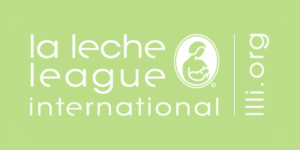
Most lactation consultants will come visit you at home. It’s awesome that they get to see you in your natural habitat. During this visit, the LC will help you with positioning the babies while feeding, she’ll also answer any questions or concerns you have, and she’ll weigh the babies before and after the supervised feed to see how much they are actually eating.
This home visit is a priceless tool during the most difficult period of breastfeeding, so don’t neglect this step.
An additional resource is your local La Leche League, which can provide support throughout all the different phases of nursing. Local chapters hold monthly meetings you can attend; you can also email them with questions (if, let’s say, the meeting is during naptime). Furthermore, most hospitals and birthing centers have a nursing support group that meets weekly. If you can get you and your twinnies to it, consider that a huge win. The best way to find out about things like this is to ask around your network.
Getting Started
First, tell your doctors, nurses, and NICU team that you want to breastfeed. I get a little worked up when I think of new moms who want to breastfeed, but are not given the support or tools to succeed. This is becoming less and less common, but still happens in areas of the country that are behind the times.
Preemies
Small and premature infants can have additional issues with nursing. The suck and swallow reflex does not develop until about 36 weeks. If your multiples are born before 36 weeks (which is somewhat likely), this can be an additional roadblock to breastfeeding.
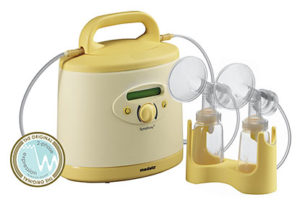
Ironically, breastmilk is even more important for premature infants, as the mother’s body produces milk specifically designed for the needs of your preemie (isn’t that cool?). If your babies are unable to feed directly from the breast or if they have a weak suck, make sure you are pumping! While at the hospital, use their hospital-grade (powerful) pumps to help establish a good supply for your babies. Pumps can be wheeled into each postpartum room, and NICUs have them in each room so you can pump while visiting your baby.
I can’t say this enough, establishing your supply is the single most important thing you can do after the babies are born. I will tell you it’s so much harder if your babies are born early and they’re in the NICU – it’s distracting and you may lose track of your breastfeeding goals, but establishing your supply is oh-so-important if you want to nurse in the future. If you miss this critical time period to establish your supply, you’ll have to fight much harder to regain the lost ground.
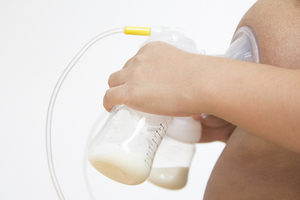
All of that said, if you are overwhelmed with all of this, please, please don’t let the pressure to breastfeed drive you off the cliff. There is so much going on – especially if your babies aren’t healthy – so please, please take care of your own needs and if you cannot do the nursing thing, it is okay. (You hear me? It is okay).
Onward —
There are several options if your babies are too small to nurse from the breast, pumping and bottle feeding being the biggies.
To do this, you will need to pump to mirror every feeding session, which is roughly 8 to 10 times in a 24-hour period. Dang, right? Yes. It is a LOT, I’m not gonna lie. For underweight/preemie babies, the goal is to put weight (fat) on those babes as quickly as possible so they can come home from the hospital.
Bottle Feeding
Again, in the early days, if your babies can’t nurse, no worries; just pump and give them your breastmilk with a bottle. The hospital and/or NICU will provide bottles for your expressed milk. Don’t worry about nipple confusion, many babies go from breast to bottle just fine (mine included) and honestly, you have bigger fish to fry.
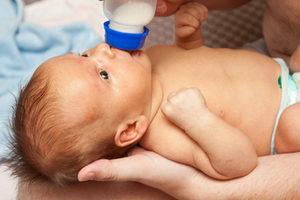
When bottle feeding your expressed milk, use the paced feeding method to prevent overfeeding. This method mimics nursing by slowing down the process (many times, milk from bottles can come out too fast) and ensures baby gets just the right amount.
Note that formula-fed infants will eat more (up to 2x more) than breastfed babies since it isn’t digested as efficiently, so don’t stress that you aren’t producing enough breastmilk vs. formula intake (if you are supplementing); it’s not an apples to apples comparison.
For daycare or grandparents (etc.) who are assisting with bottle feeding, KellyMom has an informative and easy-to-follow handout to guide people through bottle feeding.
Practicing Nursing from the Breast
Practice makes perfect!

When your babies are finally strong enough to feed from the breast, they will need to get some practice to help transition them to this new method. Many NICUs advocate “practice nursing sessions” when the babies are full; trust me – you don’t want to attempt anything new while babies are hungry (life lesson).
Your breasts should also not be too full (shortly after pumping is the perfect time) because you don’t want a strong let-down to scare or overwhelm the babies.
Oftentimes, infants in the NICU require supplementation – they just do; although many NICUs are now providing donor breast milk, which can be used (at your request) to supplement your own milk. The AAP encourages the use of donor breast milk from an established donor milk bank, when necessary.
A common tool of the trade for MOMs is a nipple shield. The most frequent issue preemies face with nursing is difficulty latching, and nipple shields help babies achieve a proper latch. The milk pools in the shield, rewarding the baby with instant milk if they take a break (similar to a bottle).
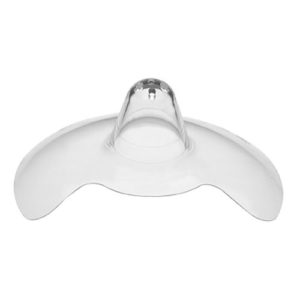
Nipple shields are also used to transition baby from the bottle to the breast. Remember that nipple shields are a short-term solution; they are simply a tool to help your babies learn to latch to your breast. You can (and should) transition away once you feel ready (or one day when you forget to use it and the babies are too impatient to wait…weaning accomplished!).
You can usually purchase a shield from your LC, but expect to pay a premium for it. Amazon has them for a very low price. Make sure you get a nipple shield and not a nipple shell (which protects sore nipples from rough clothing). You will also want a carrying case (or Tupperware container) so you can easily throw them in your diaper bag.

Another option to bottle feeding is a Supplemental Nursing System (SNS). This method helps the baby become accustomed to nursing when they are still unable to effectively nurse. The SNS is not the easiest or simplest alternative to breastfeeding; it’s one of those dire-times things. Work with your LC to ensure you have the best support.
Breastfeeding Schedules
The silver lining of having a baby with an extended hospital stay is they come home on a great schedule. Yay!
A schedule is paramount for multiples. Follow the feeding schedule your doctor or LC gives you (eventually, you can work in the sleep schedule around it). In the hospital our girls ate every 3 hours, so we stayed on that schedule when they came home.
When it comes to feeding twins, if one baby is up and the other is still snoozing, wake the sleeping baby so they can eat together. You want to avoid incongruous schedules, or you’ll never sleep. Schedules will save your sanity and help you get the rest you need to care for these babies! So do yourself a favor and stick to the schedule (i.e. they both get a bottle, both get a diaper change at the same time, etc.).
Tandem Nursing
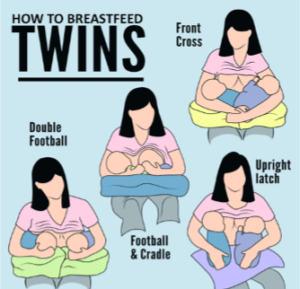
One exception: when you start out, it is recommended that you nurse your babies one at a time. This gives you the opportunity to concentrate on getting that magical perfect latch and ensures the baby is in the correct position. When you are feeding one at a time, you can cuddle with the non-eating baby at your side—or—they can take a turn in the swing/bouncer (or hand them to a partner or another caregiver, if you have a helper nearby). Once you are doing well with one-on-one feeding, you can embark on tandem nursing.
Do it when you and the babies are ready, and if it sounds appealing to you.

There are several different positions you can use for tandem nursing. The most popular position, and best position for preemies, is the double clutch/football hold. If possible, get someone to help you the first few times. Furthermore, a tandem nursing pillow will help position the babies correctly and allow you the use of your hands (for important things in life: water, food…Facebook).
Getting situated with your nursing pillow and latching the babies (albeit one at a time) requires some dexterity, so it’s easier with help.
It’s a long process, at first, to get everyone situated; you will doubt that all the “set up” is worth it. Then one day, it will become second nature and you will wonder how you ever survived without tandem feeding.
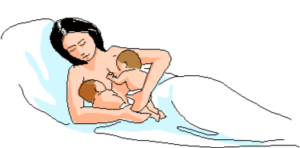
Once the babies become breastfeeding champs, you may want to try out other tandem feeding positions. My personal favorite for early morning feedings (once the girls were about 6 months) was the reclined or supine feeding position [above]. Stack some pillows behind you to prop you up, have each baby straddle a thigh and then you can lean back; the babies will cuddle you while nursing. This works well in an over-sized recliner or in bed with some small pillows at your side to help prop up your arms. I like this as an alternative to tandem side laying; stacking my girls never really worked for us.
Exclusive Pumping
If you become an exclusive pumper, know that you CAN do this, mama! Pumping is mentally straining, so a positive attitude and the support of your family are essential!
The general guideline is to pump no more than 20 minutes each “session.” Many mamas fit in an extra pumping session in the morning, when it is easier to produce milk, to get all the extra morning gold.
Again, the paced feeding method is very important for all caregivers to understand so you aren’t wasting precious milk during feeding time. If you need to boost your breastmilk supply (and you already returned the glorious hospital grade pump), try a galactagogue like Mother’s Milk supplements and always remember to drink tons of water.
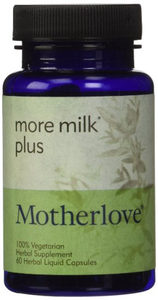
Essentially, you will be on a pumping schedule that mirrors your babies’ eating schedule (once every 3 hours or thereabouts). During your pumping sessions, try to relax; holding your babies or even looking at pictures of them will help your hormones kick in, especially during letdown. You can even close your eyes and nap, just make sure you get a hands-free bra to successfully do this.
Wardrobe & Accessories
Nursing Bracelets
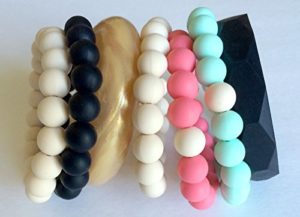
The best practice with nursing multiples is to rotate each baby on each breast to even out your milk supply. If one baby is a stronger sucker than the other, you can end up with super lopsided boObs. 😉 There are a few different methods to rotate breasts…
Baby A can be assigned to the right side Monday, Wednesday, Friday, and Sunday, OR, you can simply switch every feeding. With my horrible memory and sleep deprivation, I needed a foolproof method of remembering, so I used a nursing bracelet.
With a nursing bracelet, simply assign it to one of the babies and switch the bracelet to the other side daily to indicate which side each is on. Note that any bracelet that is easy to get on and off will do the job. You do not want little clasps that are hard to get at (imagine moving it early in the morning or late at night). In a pinch, a rubber band or hair elastic also does the trick (just don’t put your hair up and forget what side it was on!)
There are various teething toy bracelets that you can wear and also let the babies chew on. Pura Vida sells these bracelets made by Costa Rican artisans; they have a charity section that gives portions of the proceeds to various causes.
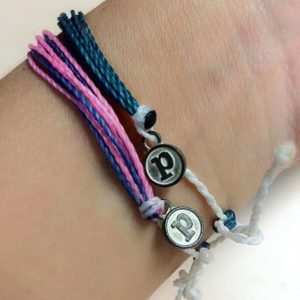
Clothing – Bras, Shirts, Dresses and More
Easy access to your boobs is ultra important during the first couple of months. The big thing for nursing twins is that you need to expose both breasts at the same time for tandem feeding. Hence, “side pull” nursing wear is not practical for MOMs. Also, make sure you have clip down bras, tops, and dresses to easily nurse in.
Wire-free bras are recommended for nursing mothers to prevent any clogged ducts. Our top pick is the Bravado.
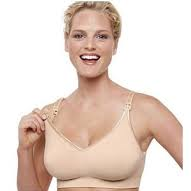
Nursing tanks are perfect for when you can go bra-less (a.k.a. at home). I lived in H&M’s nursing tanks the entire first year while at home. When you re-enter the world, I like Undercover Mama tanks that clip on to your nursing bra. They’re good for postpartum tummy coverage and easy tandem nursing access.
Finally, since sleep bras aren’t practical (they only expose one breast at a time), either wear a tank & PJ pants to bed or get yourself a nursing nightgown.
You can do this, mamas!